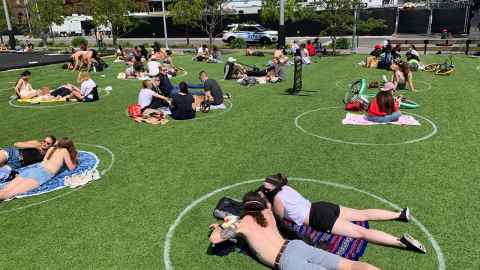A crisis of public spaces
17 June 2020
Opinion: Diane Brand asks what the post-pandemic city will look like and how do we adjust our concept of urbanism to accommodate it?

Public spaces where people are able congregate, streets, squares, parks and beaches, are enshrined in law as a location where any citizen, provided they are law-abiding, can be. Facilities such as shopping malls and sports stadia give the appearance of being public due to their scale and concentration of activity, but they are in the main privately-owned, and require certain behaviours, to gain and retain admittance.
The emergence of the virtual world more than two decades ago presented a challenge to the notion of public space, and commentators at the time predicted there would be a retreat from the physical world into online spaces and communities. This did not eventuate to the extent predicted, and the provision of new open space in cities has accelerated to counteract increased densities.
However, the advent of Covid-19 raised a question regarding the new status of public space, shifting both its meaning and form. The burgeoning of online congregation, using Zoom, Skype, webinars and the like for teaching, meeting, worshiping and socialising, has seen us explore the limits of online interaction but also the advantages it offers for convenience, health and safety, and flexibility.
Historically, the vibrancy of New Zealand public spaces has been moderated by the low-density character of our cities, and our cultural preference for locating leisure activities in our own backyards.
As predominantly non-apartment dwellers in a nation that from its outset has favoured a suburban disposition, the city is not our playground and our quarter acre is. High pedestrian counts and population density inject public spaces with extended hours of vitality and a greater volume of activity, but with a small and distributed population, the threshold to achieve robust levels of public interaction on a 24-hour basis is high.
Currently public spaces globally are facing multiple challenges. At one extreme is the emptiness and desolation wrought by either regulation or fear of Covid-19. On the other hand, we have government precincts bristling with protesters defending individual rights and liberties in the face of disease and death.
The latter of course reflects the traditional mode of public space interactions. These urban crucibles have supported and cultivated waves of joy, revolution or protest, across a spectrum of international histories. We habitually return to these sites for the communal rites of discontent or celebration.
Public space has another more pragmatic function. These are also the places people retreat to when their homes are left devastated by earthquakes, tsunamis or hurricanes. They are the sites of Urban Search and Rescue team operations and temporary hospitals. We saw this in Latimer Square after the 2011 earthquakes in Christchurch, and we have seen it in Central Park in New York in the current Covid-19 crisis.
Public spaces, as safe overflow spaces for operations critical to response and recovery, give us the resilience to survive natural and pandemic disasters.
In lockdown and through to Level 2, our safe places were our homes. However, what is the plan if a pandemic and an earthquake overlap in the same place at the same time – leaving us unsafe at home and unsafe in public space? Has our disaster planning response taken account of this collusion of viral and environmental threats?
In countries still battling Covid-19, public spaces have been redesigned to accommodate physical distancing. These include beaches gridded to accommodate whatever distancing the jurisdiction in question requires, large circles drawn on the grass in Domino park in Williamsburg, New York, showing where you and your bubble can locate and interact, and a multiple mono-maze configured so people can follow individuated paths to the maze centre along multiple parallel non-intersecting routes.
All of this is a clever, timely and responsible approach to social distancing for safety in large outdoor spaces, but it misses the fundamental point of public space: It is communal and represents at an urban scale the aspirations, values and culture of the society. It was significant that New Zealanders, wanting to commemorate Anzac Day with a Dawn Service, did so at their letterboxes on the edge of their communal suburban space, the street.
Moreover, these spaces do not float in abstract plane of space. Open spaces are contained by building edges that enliven them with activities such as restaurants, shops, bars and cafes. These attract high foot traffic that give public spaces security, liveliness, and interest.
However, the bustle, colour and variety of retail has already been retreating into malls for more than half a century, leaving our main streets struggling. Public space is at risk in towns and cities alike, and has been for some time. The arrival of Covid-19 exacerbated questions of whether businesses will survive in sufficient volume to sustain and support a viable and extensive public realm. Will we need to devise other mechanisms to support our public collective life? What will the post-pandemic city look like and how do we adjust our concept of urbanism to accommodate it?
Our cities need to change anyway in the face of climate change, rising sea levels and extreme weather events. The Covid-19 crisis presents a new dimension of changes that are now urgent.
Professor Diane Brand is Dean of the Faculty of Arts and Creative Industries.
This article reflects the opinion of the author and not necessarily the views of the University of Auckland.
Used with permission from Newsroom A crisis of public spaces 17 June 2020.
Media queries
Alison Sims | Research Communications Editor
DDI 09 923 4953
Mob 021 249 0089
Email alison.sims@auckland.ac.nz